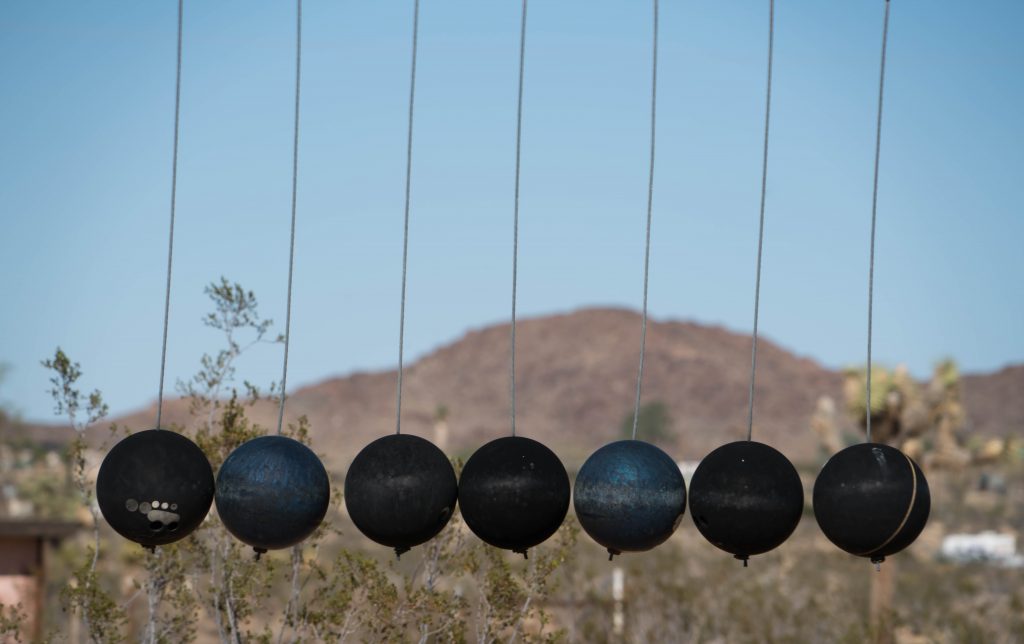The desert in Joshua Tree is like a vast sea upon whose shore wash endless tidal waves of flotsam and jetsam.
Strolling about, you’re eventually seized by an uncontrollable urge to collect. After hours of silence and solitude, the thought suddenly arises: Why not spend a whole day — no, a week! — collecting nothing but, say, black lava-like rocks the size of a walnut? There are pieces of desert driftwood that resemble devil’s claws, chips of colored glass, worn smooth by wind and sand, and desiccated cactus skeletons.
As for the man-made detritus, what’s strange is the randomness. Why, in the middle of nowhere, a miniature beaded lamp shade, a corroded doll’s head, a derelict pair of Wahl hair clippers? Why, far from any dwelling, a brush dried stiff as concrete with orange paint, nestled at the base of a cholla?
The desert draws people from two very different ends of the spectrum. At one end are the despoilers: those who dump their garbage, tear up the earth with dirt bikes, or build meth labs.
Then there are people like Noah Purifoy (1917-2004), who over the course of many years in the desert collected piles of the kind of discarded junk described above, made art from it, and created the Outdoor Desert Art Museum of Assemblage Sculpture that is now visited by people from all over the world.
Purifoy was born in Snow Hill, Alabama, but lived most of his life in Los Angeles and later Joshua Tree. He earned a bachelor’s degree from Alabama State Teachers College, a master’s degree in social service administration from Clark University, and after moving to LA, a bachelor’s degree in fine arts from the Chouinard Art Institute (now CalArts) in 1956.
He co-founded and was first director of the Watts Towers Art Center in the 1960s. The work that put him on the art map, “66 Signs of Neon” (1966), was comprised of two tons of charred debris that he and a friend collected in the wake of the Watts riots. He was appointed to the California Arts Council in 1976 and served for the next 11 years.
Purifoy moved to the desert at 72 — largely because he lacked a retirement fund and could no longer afford to live in LA. At first he didn’t much like it there. But the poverty of outward activity and muted palette grew on him. He came to love the browns, beiges, and purples, and the long horizon that gave his imagination room to roam.

From 1989 until his death, on 10 acres of land he built a series of assemblages and installations from among other items: old tires, toilet seats, glass blocks, old windows, baling wire, plywood, metal pipe, sneakers, bicycles, mannequins, cathode rays, shopping cart handles, and umbrella spines.
While alive, he gave tours and informal workshops to aspiring assemblage artists. Though his work was highly sophisticated, he didn’t hold with airy-fairy art theories and urged his admirers to avoid looking for hidden symbols or meanings.
And though he was keenly aware of the political issues of the day, he worked social justice concerns into his pieces in a way that evokes reflection — and admiration for his genius — rather than rage.
In an informal interview with Sue Welsh, his colleague and representative for more than 40 years, Purifoy observed that he viewed art as a vehicle for transformation, stating that he simply wanted to be known as an artist who made art for the sake of change and who strove to understand art and its role in the world.
The open desert, from which most of the “junk” came in the first place, is just the right backdrop for these 30 or so large-scale works: “Adrian’s Little Theater,” “Shipwrecked,” “Bessemer Steel,” “Voting Booth,” “Gallows,” “Aurora Borealis,” “Carousel.”
There they all sit, exposed to the baking heat of summer and the abrasive, sand-laden winds of winter. A Quonset hut, totem poles, what looks like a curved children’s slide made of aluminum cafeteria trays.
My favorite piece consisted of two thin metal uprights and a wooden beam crosspiece from which are suspended seven bowling balls: simple, stark, and deeply satisfying. Weathered by the sun, they range in color from black, to dark gray, to ashy blue.
Till then, I hadn’t known there is something in my heart that “desired” the sight of seven heavy perfectly round balls, each suspended from a piece of wire and casting ever-changing shadows on the sand below.
Scoff all you want. But thoughts like these arise in the vastness of the desert — thoughts that would never come, say, sitting in gridlock on the 405 or waiting in line at the Hollywood Bowl.
But drive out, take the self-guided tour and see for yourself. The museum is open from sunrise to sunset and is free — donations welcome of course. Breathe deeply, let your shoulders relax. Wander freely. Admire Purifoy’s intelligence, craft, creativity, sense of humor, and soul.
“As you know,” he observed, “most artists are extremely sensitive to noise, because they spend quiet times in their head. … Here in the desert, the rabbits, the birds, the scorpions, the lizards all run quiet.”
Heather King is a blogger, speaker and the author of several books. For more, visit heather-king.com.
SPECIAL OFFER! 44 issues of Angelus for just $9.95! Get the finest in Catholic journalism with first-rate analysis of the events and trends shaping the Church and the world, plus practical advice from the world’s best spiritual writers on prayer and Catholic living, along with great features about Catholic life in Los Angeles. Subscribe now!

